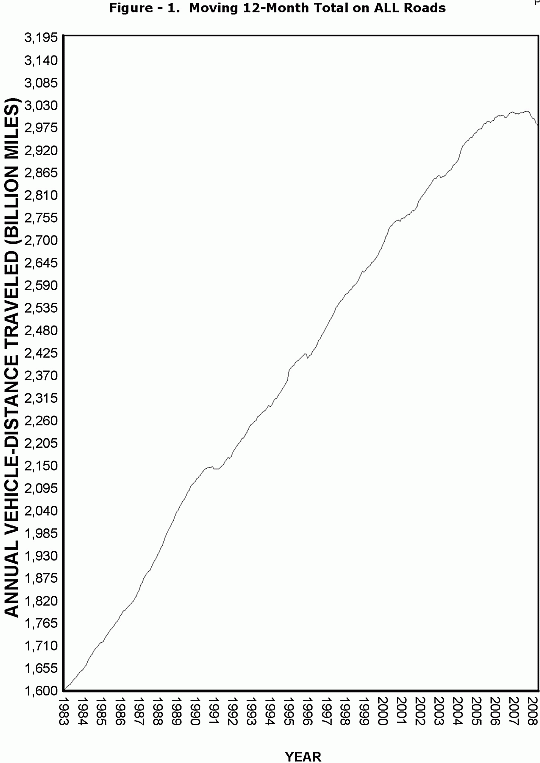June 2008 saw another sharp drop in vehicle miles traveled (VMT) according to the Federal Highway Administration’s monthly report on “Traffic Volume Trends.”
Americans drove 4.7 percent less, or 12.2 billion miles fewer, in June 2008 than June 2007 — beating the record-setting drop of March.
Since last November, Americans have driven 53.2 billion miles less than they did over the same period a year earlier — topping the 1970s’ total decline of 49.3 billion miles …
The moving 12-month trend-line is startling and again makes clear $4 a gallon is the first (but not the last) genuine tipping point for U.S. drivers:

I think that the WSJ‘s Environmental Capital blog has accepted a U.S.-centric view that misses the key point with their post, "Driving’s Really Down — But For How Long?":
The big question — will the driving downturn last? Oil prices have already come down more than 20% in the last month, and gasoline prices are falling too (if more slowly). The travel industry thinks people are getting used to pricier gas, and thinks there’ll be a rebound. From AP:
Travel Industry Association spokeswoman Cathy Keefe said the June driving decline “is not surprising, given the environment that we were in.” But she was optimistic that the recent drop in gas prices to below $4 a gallon in many parts of the country will have travelers on the road again. “I think people have started to take the increase in gas prices somewhat more in stride,” Keefe said.
Higher oil prices stunted demand, which in turn have helped bring oil prices back down. Now what?
Americans have cut back on oil consumption about 800,000 barrels a day in the first half of this year. But global demand had been rising 1 to 1.5 million barrels a day each year for a while now. So unless the United States keeps reducing demand at this pace — which is obviously quite unlikely absent a major push to fuel-efficient or alternative fuel vehicles — we will very rapidly find ourselves back in the supply-demand mismatch that drove oil prices up to record levels in the first place.
It is time for the media and the MSM’s “experts” and politicians to take off the rose-colored glasses once and for all — the price of oil is now not in the control on U.S. consumers or even the Saudis. We are headed toward $6 gas and $8 and then higher. Whether it occurs in two years or five years or 10 years depends primarily on whether the world falls into a global recession or, on the other hand, whether there is yet more conflict in oil rich regions.
Who is going to tell the public this truth?
This post was created for ClimateProgress.org, a project of the Center for American Progress Action Fund.


